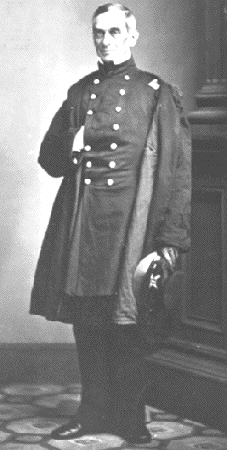In eastern Kentucky, Brigadier General George H. Thomas, commanding several western regiments organized in the state since mid-July, faced Brigadier General Felix K. Zollicoffer's four Confederate regiments as they moved through the Cumberland Gap toward Somerset, September 12. Assuming overall command of forces in the Confederate Western Department, General Albert Sidney Johnston ordered central Kentucky invested on September 18, with the occupation of Bowling Green by a growing secessionist army commanded by Brigadier General Simon Bolivar Buckner. Union forces on this front were unprepared to meet the threat.

|
During the first week of September, Brigadier General Robert Anderson, a native Kentuckian from Jefferson County, established Headquarters, Department of the Cumberland, at Louisville, Kentucky. His last command had been the Union's Charleston Harbor bastion, Fort Sumter. Anderson had now been assigned the monumental task of organizing the defense of Kentucky with the barest of assets. Posting a proclamation on his arrival at Louisville, Anderson told the people of Kentucky, "Called by the Legislature of this, my native State, I hereby assume command of this department. I come to enforce, not to make, laws; and God willing, to protect your property and your lives... I call you to arms for self-defense, and for the protection of all that is dear to freemen. Let us trust in God and do our duty as did our fathers." [9] |
General Anderson began to consolidate all available military resources in the Louisville area. He tirelessly monitored supplies, directed troop movements across the state, lobbied for aide, and received the frightened committees of influential citizens clamoring for protection against imminent invasion. Reports of a Rebel army approaching Louisville along the rail line from Nashville created near panic in the surrounding communities. Anderson hurriedly gathered forces to meet the threat.
Just across the river in Indiana, Colonel Lovell H. Rousseau of Louisville commanded and trained increasing numbers of local volunteers known as the 'Louisville Legion.' Welcomed to the state by Governor Morton, Rousseau established Camp Joe Holt, on the banks of Silver Creek near the Falls of the Ohio between the towns of New Albany and Jeffersonville. General Anderson would rely on assistance from those men to secure Louisville.
Serving Anderson as field commander during this period came Brigadier General William T. Sherman, a recent arrival from the eastern battlefield surrounding the stream called Bull Run near Manassas, Virginia. General Sherman marshaled the available troops, bolstered by Rousseau's men, to establish defenses around Louisville and to move on key points south, forming a fortified perimeter around the city. Union troops moved south along the Louisville & Nashville Turnpike to occupy Elizabethtown, on September 20. 1861. With this town secured, Sherman turned his attention to the vital railways.
Acting under orders from General Buckner, Major James M. Hawes, commanding a Confederate infantry battalion of 600 men and an artillery battery, seized the railroad bridge over the Green River at Munfordville two days earlier. Raiding parties, led by Confederate Major Thomas H. Hays, traveled north on the Louisville & Nashville Railroad to Elizabethtown to confiscate all the rolling stock in the area. They also destroyed the bridge over the Rolling Fork River ten miles north of Elizabethtown. As they retreated to Munfordville, these raiders demolished several other rail bridges, trestles and culverts along the line. It soon became Sherman's sole responsibility to respond to this incursion.
General Sherman assumed command of the Department of the Cumberland in early October, after General Anderson relinquished his post due to failing health. The overwhelming strain of his current duties, coupled with the experiences of Fort Sumter, forced Anderson to make this decision despite a desire to serve his home state. His reluctance to leave his mission eased somewhat by the conviction that this important responsibility fell to such an able officer as Sherman. [10]
As Sherman recalled later in his memoirs, "The daily correspondence between General Anderson and myself satisfied me that the worry and the harassment at Louisville were exhausting his strength and health, and that he would soon leave. On a telegraphic summons from him, about the 5th of October, I went down to Louisville, when General Anderson said he could not stand the mental torture of his command any longer, and that he must go away, or it would kill him." Three days later, Sherman officially assumed command. [11]